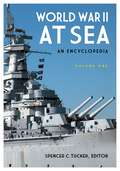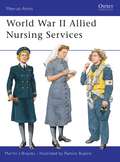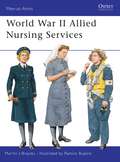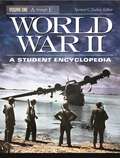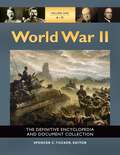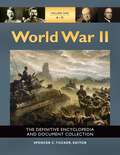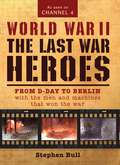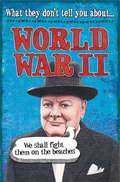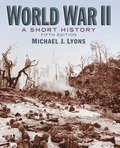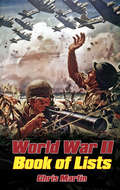- Table View
- List View
World War II Croatian Legionaries: Croatian Troops under Axis Command 1941–45 (Men-at-Arms #508)
by Vladimir Brnardic Višeslav AralicaAs Europe descended into war the newly formed state of Croatia found itself an ally in Nazi Germany. Tens of thousands of Croatians volunteered for the German Wehrmacht, with Croatian-badged units created within the Army, Navy, Luftwaffe, Waffen-SS and Police force. When Hitler turned his attention to Stalin's Soviet Union many of these men found themselves thrown into the fray, with Croatian soldiers serving at Stalingrad, fighting Tito's Partisans in the Balkans and battling against the advancing Red Army in Hungary. Aided by detailed illustrations, author Vladimir Brnardic explores the uniforms and equipment of World War II Croatian Legionaries.
World War II Battle by Battle
by Nikolai BogdanovicThis compact gift book takes thirty of World War II's most significant clashes, both the famous and the lesser known, and presents their stories in a concise, easy to digest format, accompanied by beautiful Osprey artwork plates in full colour that illuminate a key moment in each battle.World War II was the single greatest conflict the world has ever known, fought in theatres all around the globe, and many of its battles – Stalingrad, Monte Cassino, the Battle of Britain – are household names. While the Western Front in Europe is often what first comes to mind, bitter and bloody battles were also fought in Eastern Europe, Africa, Asia and the Pacific, on land, at sea, and in the air, and their many stories help illuminate both the scale and the varying character of the conflict.
World War II Battle by Battle
by Nikolai BogdanovicThis compact gift book takes thirty of World War II's most significant clashes, both the famous and the lesser known, and presents their stories in a concise, easy to digest format, accompanied by beautiful Osprey artwork plates in full colour that illuminate a key moment in each battle.World War II was the single greatest conflict the world has ever known, fought in theatres all around the globe, and many of its battles – Stalingrad, Monte Cassino, the Battle of Britain – are household names. While the Western Front in Europe is often what first comes to mind, bitter and bloody battles were also fought in Eastern Europe, Africa, Asia and the Pacific, on land, at sea, and in the air, and their many stories help illuminate both the scale and the varying character of the conflict.
World War II Axis Booby Traps and Sabotage Tactics (Elite)
by Peter Dennis Gordon L. RottmanBooby traps laid by troops in war zones in World War II are largely neglected in histories and memoirs, and rarely examined in detail. Yet for a soldier, the threat of booby traps had to be at the forefront of his mind, and an ability to find and disarm them was essential. This is the first comprehensive study of World War II's battlefield booby traps, using information from rare wartime intelligence publications to identify, illustrate and describe the tactics of both Allied and Axis saboteurs. Examining all aspects of this secretive subject, from the equipment used to the techniques of placing and finding them, this book uncovers the daily risks faced by soldiers on the ground through the course of the war.
World War II Axis Booby Traps and Sabotage Tactics (Elite #100)
by Gordon L. RottmanBooby traps laid by troops in war zones in World War II are largely neglected in histories and memoirs, and rarely examined in detail. Yet for a soldier, the threat of booby traps had to be at the forefront of his mind, and an ability to find and disarm them was essential. This is the first comprehensive study of World War II's battlefield booby traps, using information from rare wartime intelligence publications to identify, illustrate and describe the tactics of both Allied and Axis saboteurs. Examining all aspects of this secretive subject, from the equipment used to the techniques of placing and finding them, this book uncovers the daily risks faced by soldiers on the ground through the course of the war.
World War II at Sea [2 volumes]: An Encyclopedia [2 volumes]
The war at sea was a key aspect of World War II, one that is too-often under-studied. This comprehensive encyclopedia shares current understandings of the struggle to control the seas during that conflict—and it opens our eyes to the reasons sea power continues to be of critical importance today.Scholarly treatment of World War II is constantly changing as new materials inform new interpretations. At the same time, current military operations lead to reevaluation of the tactics and technologies of the past. Marshalling the latest information and insights into this epic conflict, World War II at Sea: An Encyclopedia will enable students and other interested readers to explore specific naval engagements, while also charting the transformation of naval history through innovations in ordnance.In treating the naval aspects of World War II, this two-volume ready reference enhances the understanding of a part of the war that is often overshadowed by the fighting on land and in the air. The encyclopedia focuses on the events, individuals, organizations, and ideas that shaped the world's navies during World War II, as well as the resultant battles that changed naval history. It also covers the numerous innovations that occurred during the conflict and shows how strategies evolved and were executed.
World War II at Sea: A Global History
by Craig L. SymondsAuthor of Lincoln and His Admirals (winner of the Lincoln Prize), The Battle of Midway (Best Book of the Year, Military History Quarterly), and Operation Neptune, (winner of the Samuel Eliot Morison Award for Naval Literature), Craig L. Symonds has established himself as one of the finest naval historians at work today. World War II at Sea represents his crowning achievement: a complete narrative of the naval war and all of its belligerents, on all of the world's oceans and seas, between 1939 and 1945. Opening with the 1930 London Conference, Symonds shows how any limitations on naval warfare would become irrelevant before the decade was up, as Europe erupted into conflict once more and its navies were brought to bear against each other. World War II at Sea offers a global perspective, focusing on the major engagements and personalities and revealing both their scale and their interconnection: the U-boat attack on Scapa Flow and the Battle of the Atlantic; the "miracle" evacuation from Dunkirk and the pitched battles for control of Norway fjords; Mussolini's Regia Marina-at the start of the war the fourth-largest navy in the world-and the dominance of the Kidö Butai and Japanese naval power in the Pacific; Pearl Harbor then Midway; the struggles of the Russian Navy and the scuttling of the French Fleet in Toulon in 1942; the landings in North Africa and then Normandy. Here as well are the notable naval leaders-FDR and Churchill, both self-proclaimed "Navy men," Karl Dönitz, François Darlan, Ernest King, Isoroku Yamamoto, Erich Raeder, Inigo Campioni, Louis Mountbatten, William Halsey, as well as the hundreds of thousands of seamen and officers of all nationalities whose live were imperiled and lost during the greatest naval conflicts in history, from small-scale assaults and amphibious operations to the largest armadas ever assembled. Many have argued that World War II was dominated by naval operations; few have shown and how and why this was the case. Symonds combines precision with story-telling verve, expertly illuminating not only the mechanics of large-scale warfare on (and below) the sea but offering wisdom into the nature of the war itself.
World War II at Sea: A Global History
by Craig L. SymondsAuthor of Lincoln and His Admirals (winner of the Lincoln Prize), The Battle of Midway (Best Book of the Year, Military History Quarterly), and Operation Neptune, (winner of the Samuel Eliot Morison Award for Naval Literature), Craig L. Symonds has established himself as one of the finest naval historians at work today. World War II at Sea represents his crowning achievement: a complete narrative of the naval war and all of its belligerents, on all of the world's oceans and seas, between 1939 and 1945. Opening with the 1930 London Conference, Symonds shows how any limitations on naval warfare would become irrelevant before the decade was up, as Europe erupted into conflict once more and its navies were brought to bear against each other. World War II at Sea offers a global perspective, focusing on the major engagements and personalities and revealing both their scale and their interconnection: the U-boat attack on Scapa Flow and the Battle of the Atlantic; the "miracle" evacuation from Dunkirk and the pitched battles for control of Norway fjords; Mussolini's Regia Marina-at the start of the war the fourth-largest navy in the world-and the dominance of the Kidö Butai and Japanese naval power in the Pacific; Pearl Harbor then Midway; the struggles of the Russian Navy and the scuttling of the French Fleet in Toulon in 1942; the landings in North Africa and then Normandy. Here as well are the notable naval leaders-FDR and Churchill, both self-proclaimed "Navy men," Karl Dönitz, François Darlan, Ernest King, Isoroku Yamamoto, Erich Raeder, Inigo Campioni, Louis Mountbatten, William Halsey, as well as the hundreds of thousands of seamen and officers of all nationalities whose live were imperiled and lost during the greatest naval conflicts in history, from small-scale assaults and amphibious operations to the largest armadas ever assembled. Many have argued that World War II was dominated by naval operations; few have shown and how and why this was the case. Symonds combines precision with story-telling verve, expertly illuminating not only the mechanics of large-scale warfare on (and below) the sea but offering wisdom into the nature of the war itself.
World War II and the West It Wrought
by Mark Brilliant and David M. KennedyFew episodes in American history were more transformative than World War II, and in no region did it bring greater change than in the West. Having lifted the United States out of the Great Depression, World War II set in motion a massive westward population movement, ignited a quarter-century boom that redefined the West as the nation's most economically dynamic region, and triggered unprecedented public investment in manufacturing, education, scientific research, and infrastructure—an economic revolution that would lay the groundwork for prodigiously innovative high-tech centers in Silicon Valley, the Puget Sound area, and elsewhere. Amidst robust economic growth and widely shared prosperity in the post-war decades, Westerners made significant strides toward greater racial and gender equality, even as they struggled to manage the environmental consequences of their region's surging vitality. At the same time, wartime policies that facilitated the federal withdrawal of Western public lands and the occupation of Pacific islands for military use continued an ongoing project of U.S. expansionism at home and abroad. This volume explores the lasting consequences of a pivotal chapter in U.S. history, and offers new categories for understanding the post-war West. Contributors to this volume include Mark Brilliant, Geraldo L. Cadava, Matthew Dallek, Mary L. Dudziak, Jared Farmer, David M. Kennedy, Daniel J. Kevles, Rebecca Jo Plant, Gavin Wright, and Richard White.
World War II Allied Sabotage Devices and Booby Traps (Elite #184)
by Peter Dennis Gordon L. RottmanFollowing Churchill's directive to 'set occupied Europe ablaze,' the SOE and later its American sister organization, the OSS, were deployed across the continent. Outnumbered, surrounded and in great peril, these brave agents were armed with a wide variety of devices to help them achieve their objectives, including numerous pieces of sabotage equipment and cunning booby traps. This book examines these different pieces of equipment and the technicalities involved in deploying them effectively, as well as discussing the specialist equipment developed by Special Forces units, including the SAS Lewes Bomb. Touching on some of the stranger developments, such as explosives disguised as lumps of coal, the author goes on to describe the German clearance techniques that were developed to avoid these dangers. Complete with specially commissioned artwork and period diagrams together with detailed descriptions of the dangerous missions of Allied agents, this book is a fascinating insight into the secret war behind enemy lines.
World War II Allied Sabotage Devices and Booby Traps (Elite)
by Peter Dennis Gordon L. RottmanFollowing Churchill's directive to 'set occupied Europe ablaze,' the SOE and later its American sister organization, the OSS, were deployed across the continent. Outnumbered, surrounded and in great peril, these brave agents were armed with a wide variety of devices to help them achieve their objectives, including numerous pieces of sabotage equipment and cunning booby traps. This book examines these different pieces of equipment and the technicalities involved in deploying them effectively, as well as discussing the specialist equipment developed by Special Forces units, including the SAS Lewes Bomb. Touching on some of the stranger developments, such as explosives disguised as lumps of coal, the author goes on to describe the German clearance techniques that were developed to avoid these dangers. Complete with specially commissioned artwork and period diagrams together with detailed descriptions of the dangerous missions of Allied agents, this book is a fascinating insight into the secret war behind enemy lines.
World War II Allied Nursing Services (Men-at-Arms)
by Ramiro Bujeiro Martin BrayleyThe skill and care of the women of the Allied military nursing services was remembered gratefully by hundreds of thousands of wounded servicemen. The small peacetime services increased rapidly by enrolling reservists and volunteers; the great majority of the nurses who cared for Allied casualties were 'civilians in uniform', who worked tirelessly under difficult conditions and in tented hospitals close to the front lines in real danger; many nurses paid for their devotion with their lives. This first-ever fully illustrated study of the US, British, Commonwealth, and other nursing organisations includes many unpublished photographs and 24 meticulously illustrated colour figures.
World War II Allied Nursing Services (Men-at-Arms #370)
by Ramiro Bujeiro Martin BrayleyThe skill and care of the women of the Allied military nursing services was remembered gratefully by hundreds of thousands of wounded servicemen. The small peacetime services increased rapidly by enrolling reservists and volunteers; the great majority of the nurses who cared for Allied casualties were 'civilians in uniform', who worked tirelessly under difficult conditions and in tented hospitals close to the front lines in real danger; many nurses paid for their devotion with their lives. This first-ever fully illustrated study of the US, British, Commonwealth, and other nursing organisations includes many unpublished photographs and 24 meticulously illustrated colour figures.
World War II [5 volumes] [5 volumes]: 5 volumes [5 volumes]
by Spencer C. Tucker Priscilla Mary RobertsDesigned with the more visual needs of today's student in mind, this landmark encyclopedia covers the entire scope of the Second World War, from its earliest roots to its continuing impact on global politics and human society. Over 1,000 illustrations, maps, and primary source materials enhance the text and make history come alive for students and faculty alike.ABC-CLIO's World War II: A Student Encyclopedia captures the monumental sweep of the "Big One" with accessible scholarship, a student-friendly, image-rich design, and a variety of tools specifically crafted for the novice researcher. For teachers and curriculum specialists, it is a thoroughly contemporary and authoritative work with everything they need to enrich their syllabi and meet state and national standards. Ranging from the conflict's historic origins to VJ Day and beyond, it brings all aspects of the war vividly to life—its origins in the rubble of World War I, its inevitable outbreak, its succession of tumultuous battles and unforgettable personalities. Students will understand what the war meant to the leaders, the soldiers, and everyday families on home fronts around the world. Featured essays look at Pearl Harbor, the Holocaust, the atomic bomb, and other crucial events, as well as fascinating topics such as signals intelligence and the role of women in war. A separate primary source volume provides essential source material for homework, test preparation or special projects. With a wealth of new information and new ideas about the war's causes, course, and consequences, World War II will be the first place students turn for the who, what, when, where, and—more importantly—the why, behind this historic conflict.
World War II [5 volumes]: The Definitive Encyclopedia and Document Collection [5 volumes]
by Dr Spencer C. TuckerWith more than 1,700 cross-referenced entries covering every aspect of World War II, the events and developments of the era, and myriad related subjects as well as a documents volume, this is the most comprehensive reference work available on the war.This encyclopedia represents a single source of authoritative information on World War II that provides accessible coverage of the causes, course, and consequences of the war. Its introductory overview essays and cross-referenced A–Z entries explain how various sources of friction culminated in a second worldwide conflict, document the events of the war and why individual battles were won and lost, and identify numerous ways the war has permanently changed the world. The coverage addresses the individuals, campaigns, battles, key weapons systems, strategic decisions, and technological developments of the conflict, as well as the diplomatic, economic, and cultural aspects of World War II.The five-volume set provides comprehensive information that gives readers insight into the reasons for the war's direction and outcome. Readers will understand the motivations behind Japan's decision to attack the United States, appreciate how the concentration of German military resources on the Eastern Front affected the war's outcome, understand the major strategic decisions of the war and the factors behind them, grasp how the Second Sino-Japanese War contributed to the start of World War II, and see the direct impact of new military technology on the outcomes of the battles during the conflict. The lengthy documents volume represents a valuable repository of additional information for student research.
World War II [5 volumes]: The Definitive Encyclopedia and Document Collection [5 volumes]
With more than 1,700 cross-referenced entries covering every aspect of World War II, the events and developments of the era, and myriad related subjects as well as a documents volume, this is the most comprehensive reference work available on the war.This encyclopedia represents a single source of authoritative information on World War II that provides accessible coverage of the causes, course, and consequences of the war. Its introductory overview essays and cross-referenced A–Z entries explain how various sources of friction culminated in a second worldwide conflict, document the events of the war and why individual battles were won and lost, and identify numerous ways the war has permanently changed the world. The coverage addresses the individuals, campaigns, battles, key weapons systems, strategic decisions, and technological developments of the conflict, as well as the diplomatic, economic, and cultural aspects of World War II.The five-volume set provides comprehensive information that gives readers insight into the reasons for the war's direction and outcome. Readers will understand the motivations behind Japan's decision to attack the United States, appreciate how the concentration of German military resources on the Eastern Front affected the war's outcome, understand the major strategic decisions of the war and the factors behind them, grasp how the Second Sino-Japanese War contributed to the start of World War II, and see the direct impact of new military technology on the outcomes of the battles during the conflict. The lengthy documents volume represents a valuable repository of additional information for student research.
World War II: From D-Day to Berlin with the men and machines that won the war
by Dr Stephen BullThe companion volume to the groundbreaking TV series, this book tells the story of the physical, emotional and psychological journey of Allied soldiers from the beaches of Normandy to the ruins of Berlin. In their own words these brave men from Britain, the United States, Canada and Russia tell us what it was like to face the bullets, bombs, mortars, mines and artillery shells of Nazi Germany. Interviews with over 80 soldiers who fought in the conflict, totalling 150 hours, provide a new perspective on the experiences of 1944–45. Building on the high-speed, multi-camera filming of World War II weapons and munitions shown in the TV series, this book brings the terrifying reality of the war to life. Technical descriptions and the experiences of the men in the field explain the dramatic power and effect that this weaponry had on the battlefield, from the sinister simplicity of the deadly AP mine through to the immense firepower of the 88mm gun, giving the modern historian a unique insight into the last days of the war for the troops on the frontline. This is not a history of generals, of armies manoeuvring and strategic objectives. It is a book about the ordinary men put into incredible situations, deprived of sleep and food, and in constant fear of death on the long road to victory.
World War II: From D-Day to Berlin with the men and machines that won the war
by Stephen BullThe companion volume to the groundbreaking TV series, this book tells the story of the physical, emotional and psychological journey of Allied soldiers from the beaches of Normandy to the ruins of Berlin. In their own words these brave men from Britain, the United States, Canada and Russia tell us what it was like to face the bullets, bombs, mortars, mines and artillery shells of Nazi Germany. Interviews with over 80 soldiers who fought in the conflict, totalling 150 hours, provide a new perspective on the experiences of 1944–45. Building on the high-speed, multi-camera filming of World War II weapons and munitions shown in the TV series, this book brings the terrifying reality of the war to life. Technical descriptions and the experiences of the men in the field explain the dramatic power and effect that this weaponry had on the battlefield, from the sinister simplicity of the deadly AP mine through to the immense firepower of the 88mm gun, giving the modern historian a unique insight into the last days of the war for the troops on the frontline. This is not a history of generals, of armies manoeuvring and strategic objectives. It is a book about the ordinary men put into incredible situations, deprived of sleep and food, and in constant fear of death on the long road to victory.
World War II: World War Ii Ebook Two 2 (What They Don't Tell You About)
by Robert FowkeDid you know that Adolf Hilter wasn't, in fact, German?The Second World War brought horror and heartache to millions of people all over the globe, and it turned everyday living upside down too. Any history book will give you the boring facts THEY think you should know, but only this one will tell you what life during World War II was REALLY like ...
World War II: The Autobiography
by Jon E. LewisHow will the Second World War be remembered? Not as a series of strategic battles but as a dramatic turning point in world history, recorded through the personal accounts, diaries, and speeches of those that were there. World War Two: the Autobiography places centre stage the individual accounts of over 200 people who saw events unfolding before their eyes: from the first stirrings of Nazi aggression, to the phoney war and the Blitzkrieg; from the frozen wastes of the Eastern Front to life under the threat of the Blitz in London. This autobiography offers a panoramic view of the conflict and with entries from all the major figures of the war, including Churchill, Field Marshal Montgomery, Hitler, Stalin and Rommel, as well as accounts from the men and women on the front line, the home front and those unfortunate to be prisoners of war, from all sides of the conflict.
World War II: A Short History
by Michael J. LyonsHighly regarded for its concise clarification of the complexities of World War II, this book illuminates the origins, course, and long-range effects of the war. It provides a balanced account that analyzes both the European and Pacific theaters of operations and the connections between them. The Fifth Edition incorporates new material based on the latest scholarship, offering updated conclusions on key topics and expanded coverage throughout.
World War II: A Short History
by Michael J. LyonsHighly regarded for its concise clarification of the complexities of World War II, this book illuminates the origins, course, and long-range effects of the war. It provides a balanced account that analyzes both the European and Pacific theaters of operations and the connections between them. The Fifth Edition incorporates new material based on the latest scholarship, offering updated conclusions on key topics and expanded coverage throughout.
World War II: A Global History
by Michael J. Lyons David J. UlbrichFully revised and restructured, the sixth edition of World War II: A Global History offers students a concise and yet thorough textbook that examines history’s bloodiest conflict. The chapters alternate between chronological chapters on Europe and Asia-Pacific and thematic chapters on innovations, home fronts, brutal regimes, and logistics. This textbook includes the following features: A lively narrative of facts, events, people, and ideas that incorporates thoughtful analysis New material and restructured content on global factors that affected the causes, conduct, and consequences of World War II Balanced pace that does not bog readers down in too many details yet gives them sufficient depth and breadth for context Chapters, sections, and sidebars arranged in ways that can complement lectures and assignments Fifty new photographs that illustrate the human condition and weaponry during World War II. Global in focus, by blending both geographic and thematic chapters to ensure readers gain a comprehensive understanding of impact of the war worldwide, this is the perfect volume for all students of the biggest global conflict of the twentieth century.
World War II: A Global History
by Michael J. Lyons David J. UlbrichFully revised and restructured, the sixth edition of World War II: A Global History offers students a concise and yet thorough textbook that examines history’s bloodiest conflict. The chapters alternate between chronological chapters on Europe and Asia-Pacific and thematic chapters on innovations, home fronts, brutal regimes, and logistics. This textbook includes the following features: A lively narrative of facts, events, people, and ideas that incorporates thoughtful analysis New material and restructured content on global factors that affected the causes, conduct, and consequences of World War II Balanced pace that does not bog readers down in too many details yet gives them sufficient depth and breadth for context Chapters, sections, and sidebars arranged in ways that can complement lectures and assignments Fifty new photographs that illustrate the human condition and weaponry during World War II. Global in focus, by blending both geographic and thematic chapters to ensure readers gain a comprehensive understanding of impact of the war worldwide, this is the perfect volume for all students of the biggest global conflict of the twentieth century.
World War II: The Book of Lists
by Chris MartinEverything you ever wanted to know about the Second World War, from the highest-rated fighter aces to the most inventive escape equipment used to break out of Colditz; from army pay by rank to the largest battleships; from the most stirring speeches to the biggest tactical errors; from the strangest regimental mottoes to the plays most performed by ENSA; and from the dates each country joined the war to the most unlikely spies. All the major events and dates in the war are covered in detail, but equal emphasis is placed on the human experience of combat. Often poignant and always revealing, World War II: the Book of Lists offers a unique insight into the deadliest conflict in human history.




